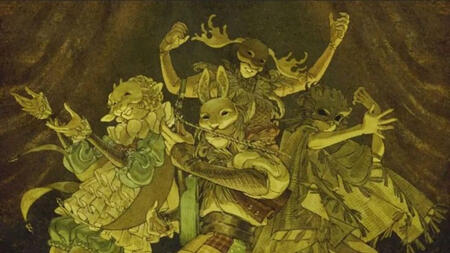
Yaelokre

"Yaelokre is a storytelling project run by Keath Ósk, (It uses They/It pronouns) honouring wonderment through song and illustration, portraying an ensemble of four young minstrels known as "The Lark", to sing of fables retold and unsung: from truth to fairytale, granting voice to the stories of Meadowlark."This carrd is unofficial, if there is ever an official yaelokre carrd, we will link it here! Please support the creator by checking its social media and listening to the first EP, Hayfields!

Characters

The Larks

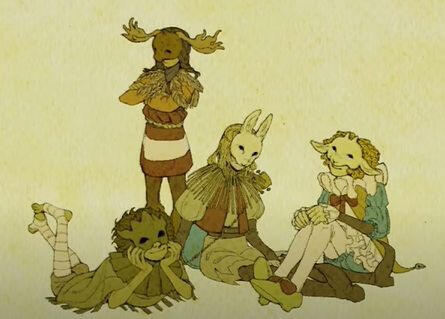
The Larks are four singers who tell the songs of Meadowlark. Orphaned children of unspecified ages, the Larks are each other's found family. They all wear masks, with each Lark corresponding to one Harker. This connection arose from Cole's idolization of the Storyteller, and it was destiny that the origins of the other Larks linked to the remaining three Harkers. They have actually met the Harkers and live together in a sanctuary.
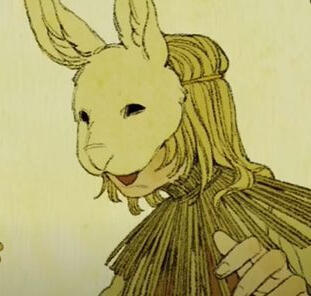
Cole
Cole wears a hare mask and is connected to the Storyteller, playing the strings to resemble them. Cole is dating Clémentine, and together they are referred to as “Colentine.” As the first Lark and "founder," Cole created the group due to his idolization of the Storyteller. Cole is the leader of the group, doing most of the writing, composition, and design. Perrine has given Cole various nicknames, including Coleman, Colesson, Coleton, Coleby, Colette, Coletraine, etc.Cole is the most passionate and can be dramatic, always dreaming and staying in his head. He is soft-spoken, bashful, and prone to anxiety, leading Clémentine to come up with the idea of masks for his sake. Despite being the least confident of the four, Cole plays a crucial role in the group. His parents are dead, and Korhys was the one who found him abandoned. Cole doesn't bother fixing his hair, which is characterized by a lengthy fringe that covers most of his head. He is the second oldest among the Larks.Cole has no understanding of romance, even when smitten with a certain silver-eyed puppet. He loves to help around the sanctuary, tending to chores and often daydreaming in the process. Cole can be found alone in the Hayfield rehearsing songs. His favorite food is the Asian pear, and he prefers bland food that is easy to eat, such as pears or bread. Even apples have been considered too sweet for him before. Cole is described as "broke in kid currency" and cannot catch a cricket for his dear life. He also "hid to be heard,".Cole's village was attacked by troops, and he witnessed his family die. He said farewell to his name, which might have been his last name or might mean he was not always Cole.
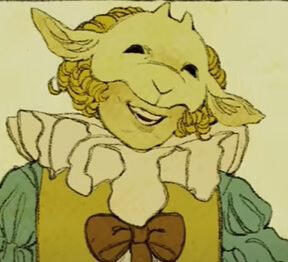
Clémentine
Clémentine wears a goat mask and is connected to the Bell-Ringer, therefore playing the bells and glockenspiel. Clémentine is dating Cole, and together they are referred to as “Colentine.” Perrine has given Clémentine the nickname "Clémmie." The idea for the masks was theirs. Clémentine ran to be remembered.Clémentine used to be kept in a very strict household to the point where they were revered as a doll, a puppet. There was control over their time, words, mannerisms, and of course, food. Due to this strict upbringing, Clémentine has yet to pick a favorite food. Despite the strictness, their household was still very loving. Clémentine has silver eyes and is the second youngest among the Larks. They are brimming with endearments and love giving kisses. Clémentine also likes to bite on candles.Clémentine comes from a richer, noble home with extremely strict standards and ran away to be whoever they wanted to be.
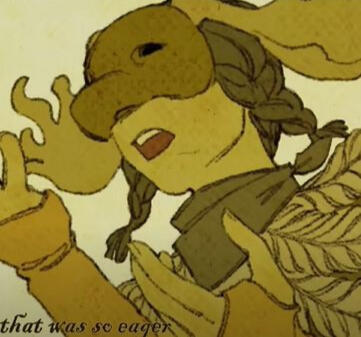
Perrine
Perrine wears a moose mask and is connected to the Croon. Perrine plays the shakers and other kinds of percussion but is mostly present for vocals. They are the oldest and most experienced of the Larks, therefore deemed the most responsible. Perrine is the smartest of them by book and quite strong. They are very ambitious and share Kingsley’s competitiveness, though Kingsley brings out the fun in her.Perrine has a habit of avoiding talk concerning their previous parents. Their old home never let them be a kid; the Larks are truly different for her. Through the Larks and their aspirations for the Harkers, Perrine could befriend their own wonderment back. Perrine was an only child who grew up with a lot of forced aspirations, which made it difficult for them to express their emotions, even though they are the most emotional. They have a hard time conversing with people their own age and despise adults due to their experience with their parents.Perrine often addresses vulnerable situations with a tactical perspective and prefers to be among animals rather than most other people (except the Larks). Perrine is progressing and working towards their problems. They like to come up with nicknames (Clémmie, King, Coleman/Colesson/Coleton/Coleby/Colette/Coletraine, etc.).
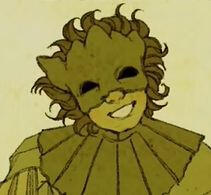
Kingsley
Kingsley wears a bark/tree mask and is connected to the Enkindled. Supposedly responsible for woodwind instruments, Kingsley later claims he doesn’t own one and instead just pretends to play the flute. Nicknamed "King" by Perrine, Kingsley has an Uncle Bertram and a Tita Amara.Kingsley is the youngest of the Larks. He is clever and full of wits, though this sometimes gets overlooked. He has a competitive, wild, and playful nature with a childish persona. Kingsley is the best at collecting crickets and therefore "rich" (in kid currency).The Larks are all orphans, but Kingsley seems to be close to his remaining family. It raises questions about whether they were raised or live with their aunt and uncle, or if they are not biologically related and just referred to as family. Do the other Larks know them?
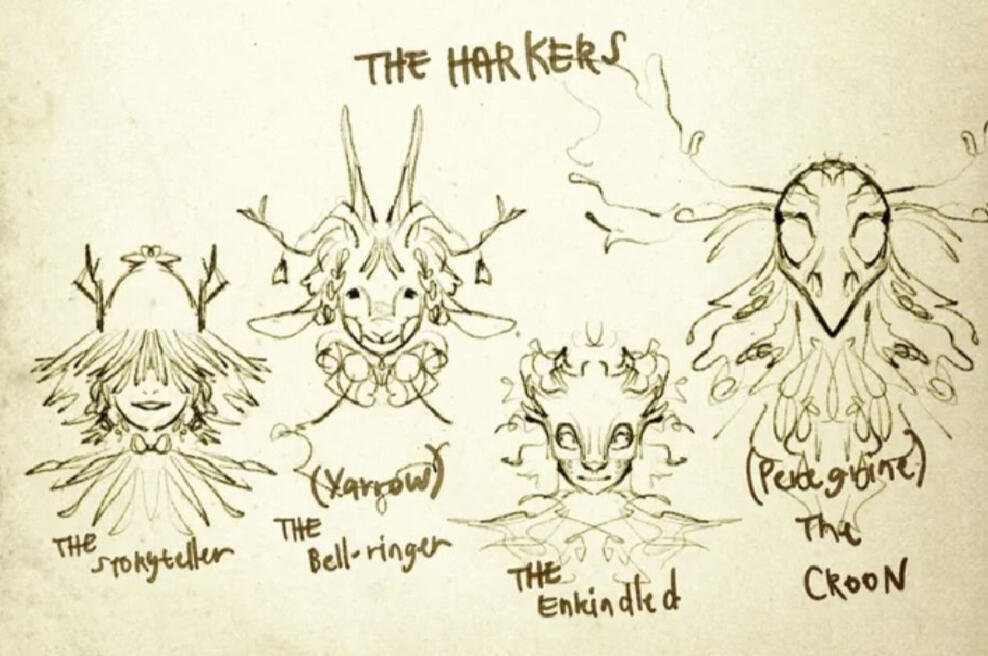
Harkers

The Harkers consist of four figures, each focused on different aspects: Storyteller, Bellringer, Enkindled, and Croon. They are prophets of the cradles, created to tell a story on their behalf. These personas appear in stories and myths, fulfilling specific roles across different tales. They are not really people, but things given life.The Harkers don’t feel and think as normal folk do, much less tackle emotions the same. They favor one thing above all else: "rhythm and permanence." For if any of the four fades, the chorus will break and wonder will be no more. Their purpose is to prevent lies and ensure the origin is not forgotten.Figures in fables and chants, the Harkers are associated with myths and not genuinely believed in. They are known predominantly by children and can act as one or separately. They are "born from bodies bereft of dreams."The Harkers form antithetical pairs: the Storyteller and Bellringer represent past and future and are confirmed to be married and paired up by folk due to their contrasting themes. This is mirrored in how their representing Larks, Cole and Clementine, are partners. The Enkindled and Croon represent order and chaos.
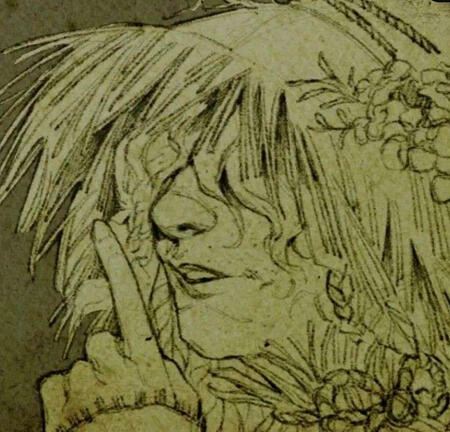
Storyteller
The Storyteller, known as "A Man Made of Straws," is poetically described as "of times past," embodying the essence of memory and historical witness. Their role as a witness is symbolized by their scarecrow form, a figure often associated with safeguarding of crops..The dramatic nature of the Storyteller is simalr to the archetype of the bard or minstrel found in many mythologies, who weave narratives with an air of theatricality and grandeur. They are married to the Bellringer, with whom they are collectively known as "Bellstrum,"The Storyteller’s has a unique trait of everything tasting like hay, except for flowers like yarrows. Yarrow, known for its medicinal properties, represents healing and remembrance in various cultures.
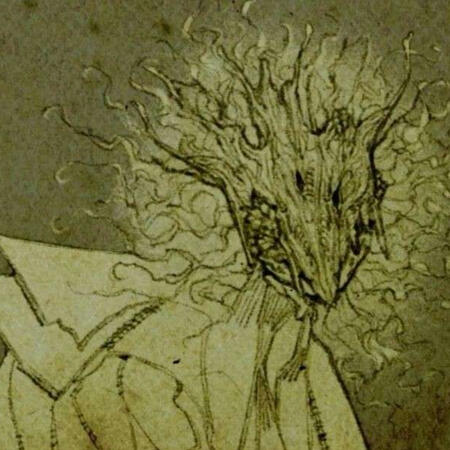
Enkindled
The Enkindled, embodies the essence of balance and equilibrium.As a shapeshifter, the Enkindled does not have one singular form but is always represented by a mask made out of bark. This ability to change form is similar to the trickster gods in various mythologies, such as Loki in Norse mythology or the Native American Coyote, who often transformed to teach lessons or maintain balance.The Enkindled has been known to take the shape of a hound, particularly in stories involving the foolish Majesty.
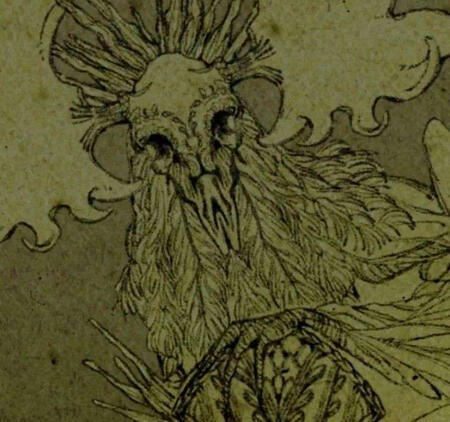
Croon
The Croon, a being of made from bones, embodies entropy, chaos, and the inevitable passage of time. As the tempest, daughtering disharmony, dishonoring stillness, and those who are afraid to listen, the Croon stands for change and entropy. However, the Harkers are said to favor permanence, which poses the intriguing question of how these concepts align. This tension might suggest that change itself is a permanent fact of life, echoing the famous paradox: "the only constant in life is change."In the tale of the Croon, it is suggested that the Croon symbolizes the passing of time and death, themes that are ubiquitous in mythological and literary traditions. This is reminiscent of the Greek god Cronus (or Chronos), the personification of time who devours his children to prevent them from usurping him, symbolizing the destructive and consuming nature of time.The Croon was narrated by Yaelokre while in a Storyteller cosplay, indicating that the Storyteller is probably the lyrical "I". In the narrative, the Croon emphasizes the importance of the message over the messenger: "My words you will remember, and yet my voice you shall forget." This reflects a common theme in folklore and myth, where the tale and its moral outlast the storyteller, similar to the way Aesop's fables have outlived Aesop himself.The tale begins in the meadows of sorrel, a plant whose name can also refer to foxes. This duality might be deliberate, playing on the idea of cunning and adaptability, traits often associated with foxes. The meadows are caught between the cervine folk of the mountains and the blood-hungry pyrefiends, potentially a neologism or term for arsonists. This setting contrasts the pastoral simplicity with ruthless violence, echoing the tension between rural innocence and urban corruption found in works like Thomas Hardy's "Tess of the d'Urbervilles."In the northeastern region, the crossroads are burdened by sorrow and believe in one god: the Croon. This hints at the content of the song "NorthEastSorrow" and might draw parallels with the ancient Greek concept of crossroads as liminal spaces where fate and decision intersect. The Harkers, though not truly gods, are placeholders for the cradles, and the people's beliefs in the tale may not be "real" within the world of Meadowlark. The Croon represents the crossroad between life and death, with the northern east possibly being a place of past massacres where only the dead walk. This is evocative of ghost towns or battlefields in historical contexts, where the weight of past violence lingers.The Croon stands for inevitable change, serving as a grim memento mori or a reminder that better days may come. Despite their god status, the Croon roams nature freely, towering above even the highest mortals. This signifies that everyone is subject to the passage of time, much like the theme in Percy Bysshe Shelley's poem "Ozymandias," where the mightiest rulers are eventually humbled by time.The Croon forbids mortals from touching certain walls and timber, except for one with a golden heart, possibly referencing the heart beneath the grove. This notion of the 'golden heart' resonates with the Arthurian legends of purity and worthiness, akin to only the worthy being able to pull Excalibur from the stone. The promise kept by this person is forgotten by others, possibly linking to the Croon or a specific individual, much like how Merlin is both a wise sage and an enigmatic figure in Arthurian lore.The lyrical "I" claims to have made people forget, raising questions about the Storyteller's role in making people forget something while being dedicated to remembering the past. This mirrors the complexities found in figures like Odin from Norse mythology, who is both a seeker of knowledge and a manipulator of truth. This might be tied to the relationship between the Storyteller and the Croon, reflecting the dual nature of memory and forgetfulness, much like the dual rivers of Lethe and Mnemosyne in Greek mythology, where one leads to forgetting and the other to remembrance.
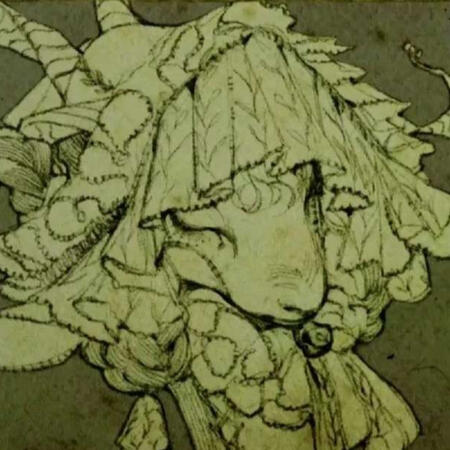
Bellringer
The Bellringer, often depicted as "a puppet," speaks of augury and is married to the Storyteller, collectively referred to as “Bellstrum.” Their pairing by the people stems from their contrasting personalities, much like how Yin and Yang symbolize the balance of opposites in Chinese philosophy. The expression "Knells of the Bellringer," commonly used by Perrine, signifies their large influence in Meadowlark.Augury, an ancient Roman practice, involved interpreting the will of the gods through observed events within a sacred space, such as weather patterns and bird behavior. The Bellringer's role in Meadowlark mirrors the Roman augur's duties, where the future was foretold by interpreting the flight and songs of birds. Romans classified birds into two groups: Oscines, which gave auspices through their singing, and Alites, which gave auspices through their flight patterns. This practice is reflected in the Bellringer's connection to augury, suggesting they interpret signs to guide the Larks.The Bellringer's association with yarrow, a flower used in traditional Chinese medicine, yarrow is used in the practice of I Ching, an ancient divination text. This connection reinforces the Bellringer's role as a guide and seer, interpreting signs to aid the Larks.